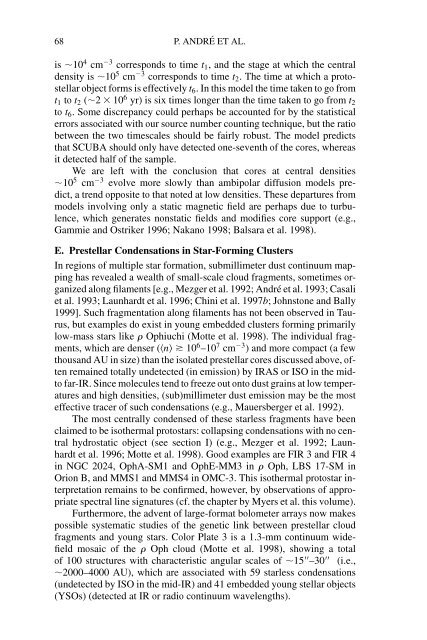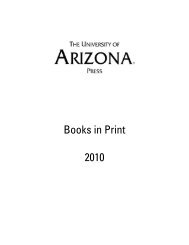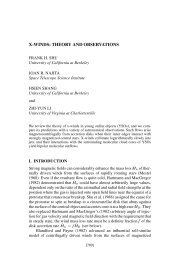from prestellar cores to protostars - The University of Arizona Press
from prestellar cores to protostars - The University of Arizona Press
from prestellar cores to protostars - The University of Arizona Press
You also want an ePaper? Increase the reach of your titles
YUMPU automatically turns print PDFs into web optimized ePapers that Google loves.
´<br />
68 P. ANDRE ET AL.<br />
4 3<br />
is 10 cm corresponds <strong>to</strong><br />
time t1, and the stage at which the central<br />
<br />
5 <br />
density is 10 cm<br />
3<br />
corresponds <strong>to</strong> time t2. <strong>The</strong> time at which a pro<strong>to</strong>-<br />
stellar object forms is effectively t6. In this model the time taken <strong>to</strong>go<strong>from</strong><br />
t<br />
6<br />
1 t o t2 ( 2 10 yr) is six times longer than the time taken <strong>to</strong> go <strong>from</strong><br />
t2<br />
t o t6. Some discrepancy could perhaps be accounted for by the statistical<br />
errors associated with our source number counting technique, but the ratio<br />
between the two timescales should be fairly robust. <strong>The</strong> model predicts<br />
that SCUBA should only have detected one-seventh <strong>of</strong> the <strong>cores</strong>, whereas<br />
it detected half <strong>of</strong> the sample.<br />
We are left with the conclusion that <strong>cores</strong> at central densities<br />
<br />
5 <br />
10 cm<br />
3<br />
evolve more slowly than ambipolar diffusion models predict,<br />
a trend opposite <strong>to</strong>that noted at low densities. <strong>The</strong>se departures <strong>from</strong><br />
models involving only a static magnetic field are perhaps due <strong>to</strong><br />
turbulence,<br />
which generates nonstatic fields and modifies core support (e.g.,<br />
Gammie and Ostriker 1996; Nakano<br />
1998; Balsara et al. 1998).<br />
E. Prestellar Condensations in Star-Forming Clusters<br />
In regions <strong>of</strong> multiple star formation, submillimeter dust continuum mapping<br />
has revealed a wealth <strong>of</strong> small-scale cloud fragments, sometimes or-<br />
ganized along filaments [e.g., Mezger et al. 1992; Andre´<br />
et al. 1993; Casali<br />
et al. 1993; Launhardt et al. 1996; Chini et al. 1997 b; Johns<strong>to</strong>ne and Bally<br />
1999]. Such fragmentation along filaments has not been observed in Taurus,<br />
but examples do exist in young embedded clusters forming primarily<br />
low-mass stars like Ophiuchi (Motte et al. 1998). <strong>The</strong> individual fragments,<br />
which are denser ( 10 –10 cm<br />
n<br />
<br />
6 7 3) and more compact (a few<br />
thousand AU in size) than the isolated <strong>prestellar</strong> <strong>cores</strong> discussed above, <strong>of</strong>-<br />
ten remained <strong>to</strong>tally undetected (in emission) by IRAS or ISO in the mid<strong>to</strong>far-IR.<br />
Since molecules tend <strong>to</strong>freeze out on<strong>to</strong>dust grains at low temperatures<br />
and high densities, (sub)millimeter dust emission may be the most<br />
effective tracer <strong>of</strong> such condensations (e.g., Mauersberger et al. 1992).<br />
<strong>The</strong> most centrally condensed<br />
<strong>of</strong> these starless fragments have been<br />
claimed <strong>to</strong>be isothermal pro<strong>to</strong>stars: collapsing condensations with nocen-<br />
tral hydrostatic<br />
object (see section I) (e.g., Mezger et al. 1992; Launhardt<br />
et al. 1996; Motte et al. 1998). Good examples are FIR 3 and FIR 4<br />
in NGC 2024, OphA-SM1 and OphE-MM3 in Oph, LBS 17-SM in<br />
Orion B, and MMS1 and MMS4 in OMC-3. This isothermal pro<strong>to</strong>star interpretation<br />
remains <strong>to</strong> be confirmed, however, by observations <strong>of</strong> appro-<br />
priate spectral line signatures (cf. the chapter by Myers et al. this volume).<br />
Furthermore, the advent <strong>of</strong> large-format bolometer arrays now makes<br />
possible systematic studies <strong>of</strong> the genetic link between <strong>prestellar</strong> cloud<br />
fragments and young stars. Color Plate 3 is a 1.3-mm continuum widefield<br />
mosaic <strong>of</strong> the Oph cloud (Motte et al. 1998), showing a <strong>to</strong>tal<br />
<strong>of</strong> 100 structures with characteristic angular scales <strong>of</strong> 15 –30 (i.e.,<br />
2000–4000 AU), which are associated with 59 starless condensations<br />
(undetected by ISO in the mid-IR) and 41 embedded young stellar objects<br />
(YSOs) (detected at IR or radio continuum wavelengths).






